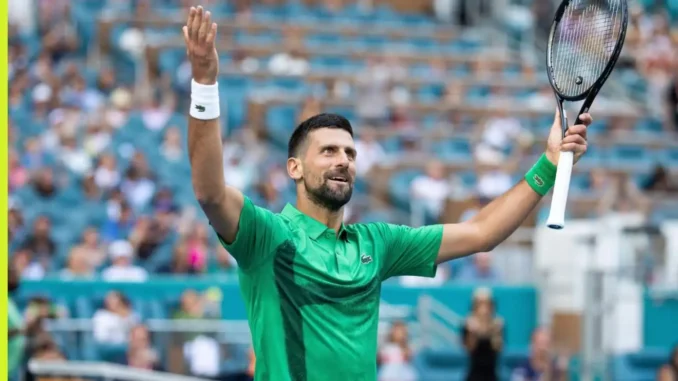
In the pulsating world of professional tennis, where every stroke is dissected and every victory celebrated, Novak Djokovic continues to carve out a legacy that’s as enduring as it is extraordinary. As the Serbian superstar, now ranked No. 5 globally, prepares to take on the clay courts of Monte Carlo in April 2025, he’s offered a rare glimpse into the mechanics of his game that have kept him at the pinnacle for over two decades. During a candid moment after his semifinal triumph at the Miami Open on March 29, 2025, Djokovic peeled back the curtain on what he considers his most overlooked weapon: his serve. “Maybe the serve has been a bit underrated,” he mused, a statement that sparked intrigue among fans and analysts alike, given the spotlight typically shines on his backhand or relentless return game.
Djokovic’s journey to the Miami Open final was a testament to his enduring brilliance. Facing Grigor Dimitrov in the semifinals, he delivered a masterclass, clinching a 6-2, 6-3 victory with a serving performance that bordered on the supernatural—landing 87% of his first serves, missing just five or six in the entire match. “I missed about five or six serves in the whole match, so that is really amazing,” he said, his tone a mix of pride and disbelief. This wasn’t just a fluke; it was the culmination of years refining a shot he’s always cherished for its “accuracy and precision” rather than sheer velocity. While others chase the thrill of a 130-mile-per-hour rocket, Djokovic opts for control, explaining, “I’d rather serve 120 miles an hour and hit the line and hit the perfect spot in the box because that’s what either wins you a point or gives you an easy first shot in the rally.”
The Miami courts, playing faster than they did six years ago when he last dominated there, amplified his serving prowess. “It helps that the court is playing pretty quickly here,” he noted, contrasting it with memories of a slower surface that demanded a different approach. This adaptability—honed over a career that boasts 24 Grand Slam titles and a record 428 weeks at No. 1—sets him apart. Yet, despite this resurgence, with his serve clicking alongside new coach Andy Murray’s guidance, Djokovic insists there wasn’t a grand overhaul. “We did work on the serve—don’t get me wrong—but we did not only work on that,” he clarified, hinting that other elements of his game received equal attention in their month-long collaboration across the U.S.
That collaboration hit a snag in the final, where 19-year-old Jakub Mensik denied Djokovic a record-extending seventh Miami title and his 100th career singles trophy. The Czech phenom edged him out in two tiebreaks, 7-6(4), 7-6(4), a loss Djokovic took with grace despite a swollen right eye that had fueled social media speculation days earlier. “I really prefer not to talk about it,” he said of the eye issue, brushing off excuses and praising Mensik’s grit. “There’s no harder task in tennis than to beat him in the finals,” Mensik acknowledged, a nod to the mountain he’d scaled. For Djokovic, the defeat left “a bitter taste,” but he found solace in the week’s highs: “Miami really brought me a lot of joy and really good sensations on and off the court.”
So why does the serve remain his unsung hero? Perhaps it’s overshadowed by his backhand’s laser-like precision or the flexibility that lets him slide across hard courts like a gymnast. Yet, in Miami, it was the serve that carried him, a quiet engine powering his march to the final. “I think I’ve been serving pretty well this year,” he reflected, admitting that while other shots faltered, this one held firm. Joking with Tim Henman post-match, he likened his serving streak to towering aces like John Isner or Reilly Opelka, a rare moment of levity from a man chasing history. As he eyes the clay season and beyond—perhaps even the 2028 Olympics at age 41—Djokovic’s underrated serve might just be the ace up his sleeve, ready to surprise a field still marveling at his longevity.
Leave a Reply